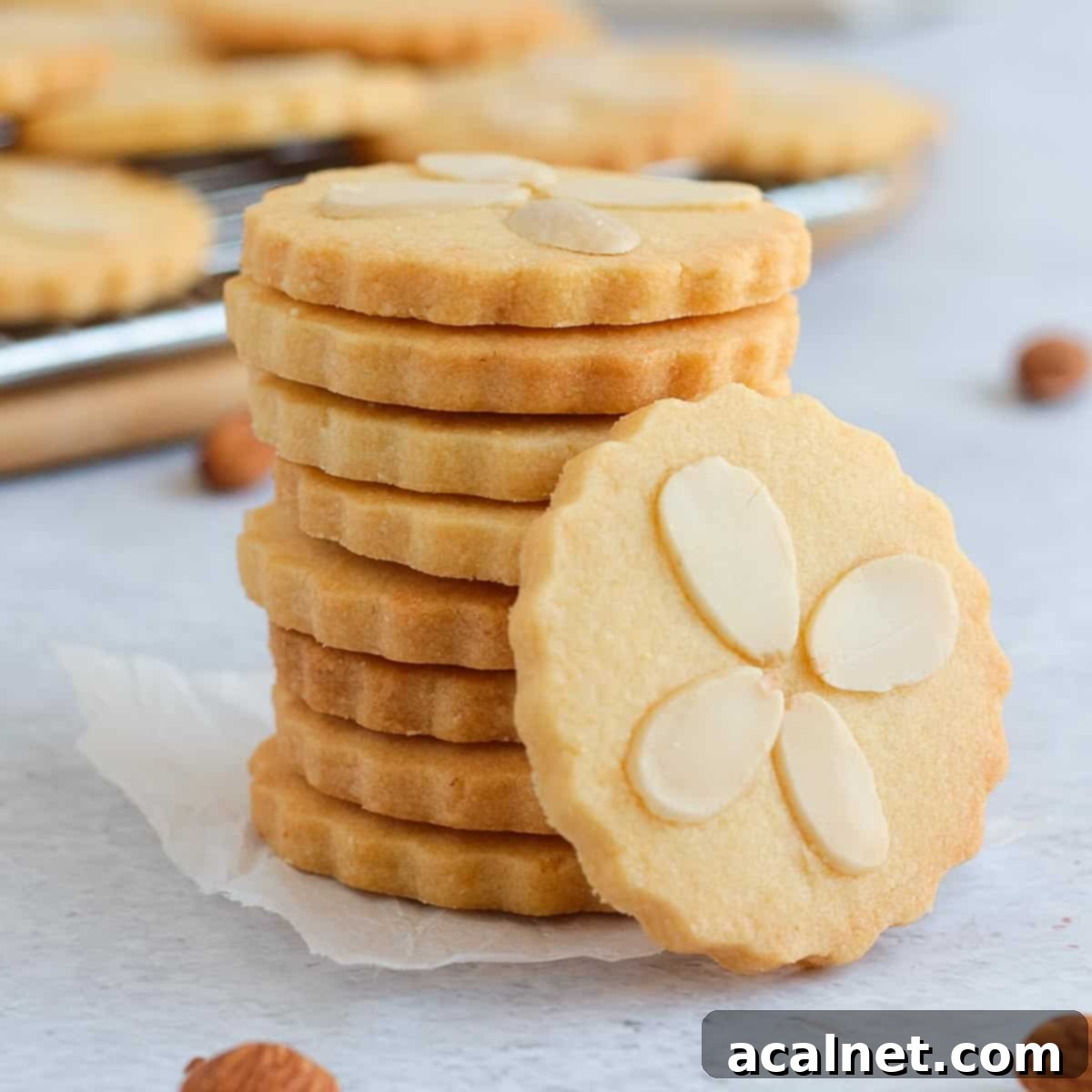The Ultimate Guide to Baking Perfect Buttery Almond Shortbread Cookies
Welcome to the definitive guide for baking the most exquisite almond shortbread cookies you’ll ever taste! These delightful treats are the epitome of buttery perfection, boasting an irresistibly crumbly texture that melts in your mouth. Crafted with just six simple ingredients, these cut-out almond meal cookies are surprisingly easy to make and offer endless possibilities for festive decoration. Whether you’re preparing for Christmas, holiday gatherings, or simply craving a comforting homemade biscuit, this recipe promises to deliver pure bliss with every bite.

Why You’ll Adore This Almond Shortbread Cookie Recipe
There’s a reason these almond shortbread cookies quickly become a favorite. Imagine a cookie that’s incredibly rich, decadently buttery, and perfectly crumbly – that’s the essence of a truly great shortbread. Now, infuse that with the delicate, nutty aroma and taste of almonds, and you have an absolute winner! These cookies are not just delicious; they are incredibly convenient to make, requiring **only 6 basic ingredients** and minimal effort, especially when prepared **in a food processor**.
Beyond their amazing flavor and texture, these almond biscuits are remarkably versatile, making them ideal for any occasion. They shine brightly during the holidays, perfect for a Christmas cookie exchange, or as a thoughtful homemade gift. As classic cut-out cookies, you have the creative freedom to shape them with your favorite holiday-themed cookie cutters – or simply keep them elegant and simple, just like we did. The decorating possibilities are endless, allowing you to personalize each batch to suit your mood or event!
If you’re a fan of our other shortbread creations, you’ll definitely want to try these. They stand proudly alongside our other popular variations:
- Strawberry Shortbread Cookies
- Lemon Poppy Seed Shortbread Cookies
- Chocolate Hazelnut Shortbread Cookies
- Pistachio Shortbread Cookies
Essential Ingredients for Flawless Almond Shortbread

These incredibly delicious Almond Shortbread Biscuits are crafted using **only 6 fundamental ingredients**. Each plays a crucial role in achieving that perfect buttery, crumbly texture and rich almond flavor:
- Flour: We use Plain / All-Purpose Flour. It’s essential to sift it before use to ensure a light, lump-free dough, contributing to the cookie’s tender texture.
- Butter: Unsalted butter is key here, and it must be **cold** and cut into small cubes. Cold butter is paramount for shortbread, as it creates pockets of steam during baking, resulting in that desirable crumbly, melt-in-your-mouth texture.
- Almond Meal: This is where the magic almond flavor comes from! While almond flour can be used, we highly recommend almond meal for its slightly coarser texture, which adds a beautiful, subtle chewiness to the shortbread. Always sift your almond meal to break up any lumps and ensure even distribution in the dough. Baking with almond meal is not just about adding a delicate texture; it infuses your baked goods with an incredible depth of nutty flavor. From Almond Flour Peanut Butter Cookies to elegant Financiers, and even our Chocolate Chip Almond Cookies or the simple 3-Ingredient Almond Cookies, it’s truly a favorite ingredient to bake with!
- Icing Sugar: Also known as Powdered Sugar. The fine consistency of icing sugar, often containing a small amount of cornstarch, helps to tenderize the dough and contributes to a delightful “snap” in the baked cookies. Again, sifting is crucial for a smooth dough.
- Egg Yolk: While traditional shortbread often omits eggs (relying on just flour, butter, and sugar), the addition of an egg yolk here is a game-changer. It significantly enhances the richness of the flavors and helps create a slightly lighter, softer, yet still wonderfully crumbly texture. It also binds the dough beautifully, making it easier to handle.
- Almond Essence: Or Almond Extract. This ingredient is optional but highly recommended to boost and intensify the natural almond flavor of the cookies, taking them from great to extraordinary. A little goes a long way in creating that distinct, sweet almond aroma.
Elevate Your Shortbread: Optional Additions
While the classic almond shortbread is perfect as is, you can always customize your batch with a few extra ingredients to introduce new flavor dimensions. Here are some fantastic ideas:
- Vanilla (Extract, Essence, or Paste): A timeless pairing with almond, vanilla adds a warm, aromatic depth.
- Citrus Zest (Orange or Lemon): Finely grated zest provides a bright, refreshing counterpoint to the rich almond and butter flavors.
- Mini Chocolate Chunks: For a delightful texture and a hint of indulgence, mini chocolate chips or finely chopped chocolate can be folded into the dough.
- Sea Salt Flakes: A pinch of flaky sea salt sprinkled on top before baking can enhance the buttery sweetness and add a sophisticated touch.

Step-by-Step Guide: Crafting Your Almond Shortbread Cookies
While these cookies can certainly be made by hand (refer to our FAQ section for manual instructions), we highly recommend using a food processor. It truly transforms the baking process, making it incredibly quick, effortless, and significantly less messy. Let’s dive into the simple steps to create these delightful treats:
- Step 1 (Photo 1): Prepare Dry Ingredients. Begin by placing the sifted Plain/All-Purpose Flour, sifted Almond Meal, and sifted Icing Sugar into the bowl of your food processor. Pulse a few times to thoroughly combine the ingredients and ensure there are no lingering lumps. This step is crucial for an even texture in your final cookies.
- Step 2 (Photo 2): Incorporate Cold Butter. Add the very cold, unsalted butter, which you’ve cut into small cubes, to the food processor. Keeping the butter cold is vital for that signature crumbly shortbread texture.
- Step 3 (Photo 3): Create Fine Crumbs. Process the mixture until it resembles fine breadcrumbs. You shouldn’t see any loose, powdery flour remaining. Aim for uniform, fine crumbs; while larger crumbs can result in flakier biscuits, fine crumbs generally yield a more consistent and even texture, which is ideal for cut-out cookies.
- Step 4 (Photo 4): Add Wet Ingredients. Introduce the Egg Yolk and Almond Essence (or Extract) to the food processor. These liquid elements will bring the dough together.
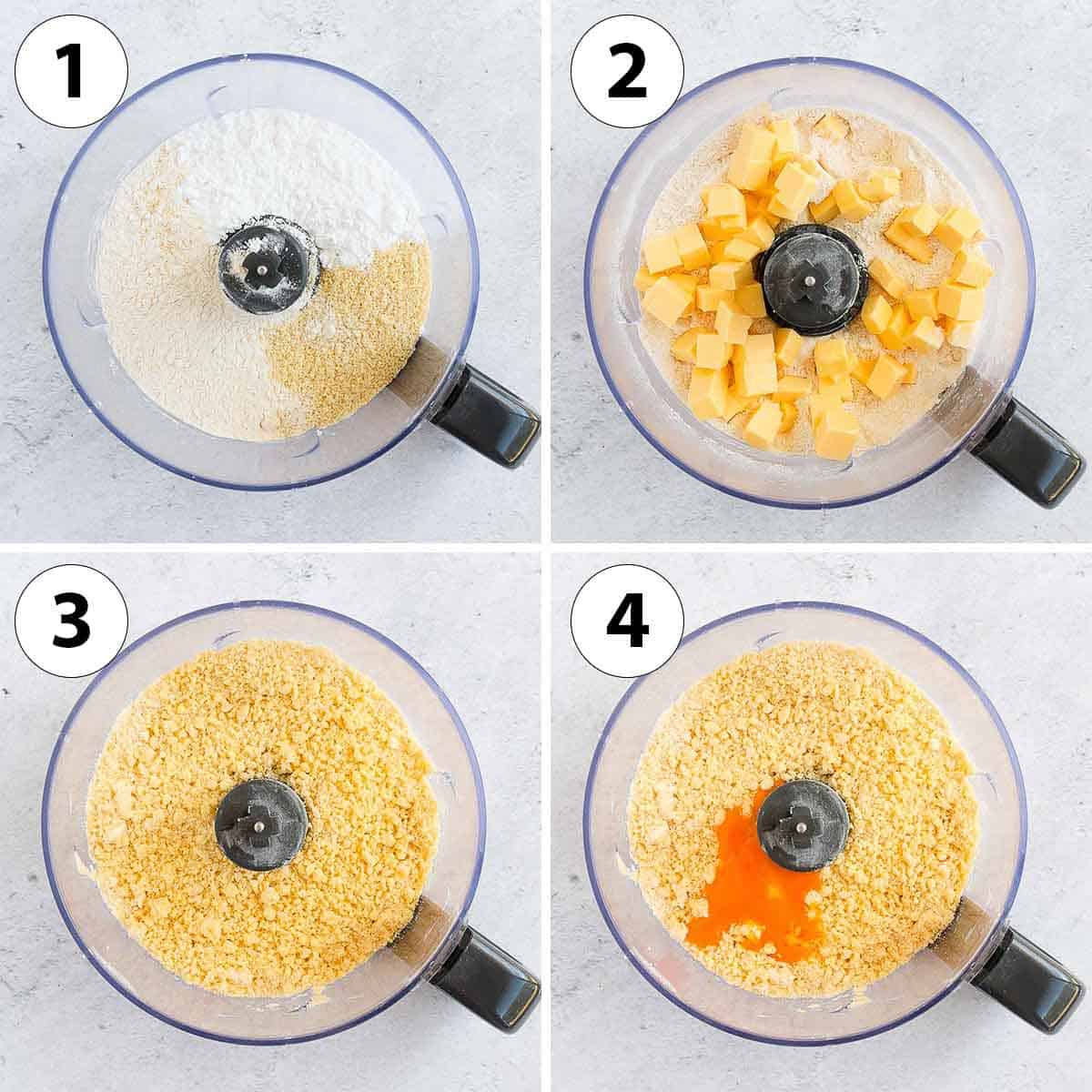
- Step 5: Form the Dough. Pulse again until the dough just begins to come together. It doesn’t need to form a perfect ball yet. The key is that if you press a small amount of dough between your fingers, it should hold together. The dough will feel quite soft at this stage, which is perfectly normal. Avoid over-processing, as this can develop the gluten and make the cookies tough.
- Step 6: Roll and Chill. Transfer the soft dough between two sheets of baking paper. This prevents sticking and makes rolling much easier. Use a rolling pin to roll the dough evenly. We recommend a thickness of **4 mm (or 1/6 inch)**. You can go slightly thicker if you prefer a more substantial cookie, but we advise against rolling it thinner than 4mm (1/6 inch) as it can become too delicate. Once rolled, place the dough (still between the baking paper) onto a flat baking tray and refrigerate for at least 30 minutes, ideally 1 hour. Chilling is a crucial step to prevent spreading during baking and to make the dough firm enough for cutting.
- Step 7: Prepare for Baking. While the dough chills, preheat your oven to 160°C (320°F). Line a large flat baking tray or cookie sheet with fresh baking paper.
- Step 8 (Photo 7): Cut Out Cookies. Remove the chilled almond shortbread cookie dough from the fridge. Using your favorite cookie cutters (a simple round fluted cutter was used here), cut out your shapes. If the dough seems to crack when you cut it, let it sit at room temperature for a couple of minutes to soften very slightly. If it becomes too soft and difficult to handle, simply pop it back into the fridge for a few minutes to firm up.
- Step 9 (Photo 8): Arrange on Tray. Carefully transfer the cut-out cookies onto the prepared baking tray. These cookies will not spread significantly in the oven, so you can place them relatively close to each other without worry.
- Step 10: Bake to Perfection. Bake for approximately 15 minutes. The edges should just begin to turn a very light golden color. Keep an eye on them; if they seem to be browning too quickly, you can slightly reduce your oven temperature. Once baked, remove them from the oven. The cookies will still be quite soft when hot, which is completely normal. Leave them to cool on the baking tray for 5 to 10 minutes before gently transferring them to a wire cooling rack to cool completely. They will firm up nicely as they cool.
Gather any leftover dough scraps, gently press them together, re-roll, chill again, and repeat the cutting and baking process until all the delicious almond shortbread dough has been used. This ensures no tasty bit goes to waste!
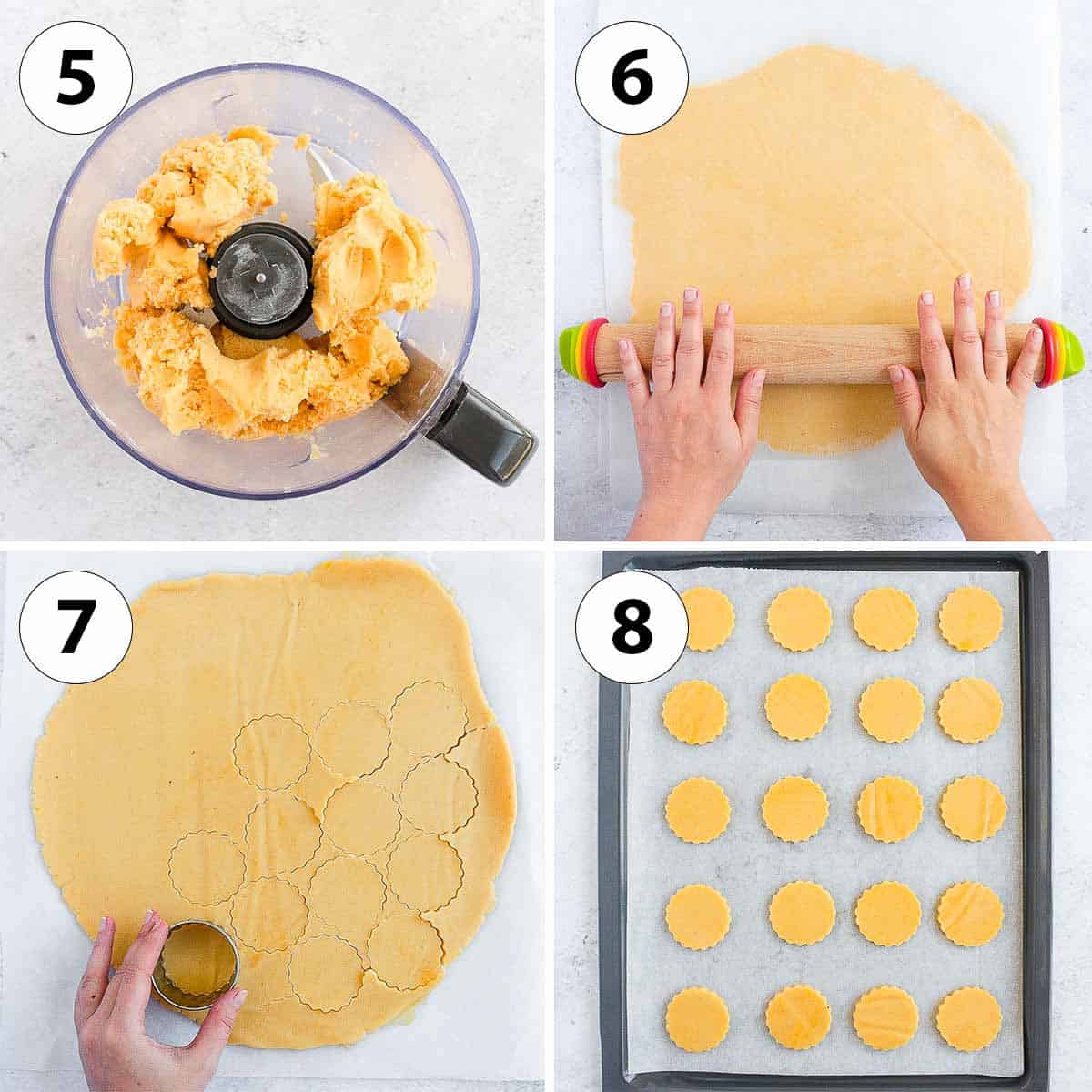
Expert Tips for Shortbread Success
Achieving the perfect almond shortbread is all about paying attention to a few key details. Follow these tips to ensure your cookies turn out beautifully every time:
- Temperature is Your Best Friend: This is arguably the most critical aspect of shortbread baking. The butter must be very cold, both when you initially mix the dough and immediately before baking. Cold butter helps create those desirable airy pockets, leading to a perfectly crumbly texture. If the cookies aren’t sufficiently chilled before baking, the butter will melt too quickly, causing the cookies to spread and lose their shape. Conversely, the dough needs to be at the right temperature for cutting and handling – too cold and it cracks, too warm and it’s sticky.
- Don’t Skip the Rest: The chilling/resting time in the fridge is non-negotiable. This period allows the butter to firm up again, preventing spreading in the oven, and also gives the gluten in the flour time to relax. Relaxed gluten results in a tender, not tough, cookie. Aim for at least 30 minutes, but an hour is ideal.
- Even Thickness for Even Baking: To ensure all your cookies bake uniformly and have a consistent texture, aim for an even dough thickness. A rolling pin with thickness rings is an invaluable tool for this, guaranteeing perfect results across your entire batch.
Common Shortbread Problems & Quick Fixes
Even experienced bakers can encounter small issues. Here’s how to troubleshoot common shortbread problems:
- The cookie dough cracks when I cut out the cookies: This usually means the dough is too cold and rigid. Simply leave it at room temperature for a couple of minutes to allow the butter to soften slightly. Once it’s a bit more pliable, resume cutting.
- The dough is too soft to handle: Because shortbread dough is rolled relatively thinly, it can quickly warm up and become difficult to manage or transfer to the baking tray. If it becomes too soft, simply place the dough back in the fridge (or even the freezer for a few minutes) to firm up again. Work quickly, and don’t be afraid to rechill as needed.
- Why did my shortbread cookies go flat? Flat shortbread cookies are almost always a temperature issue. Either the butter in your dough wasn’t cold enough to begin with, or the cookies weren’t sufficiently chilled before baking, causing the butter to melt and spread rapidly in the oven. Another culprit could be an oven temperature that is too high, leading to quick melting before the structure sets. Ensure your oven thermometer is accurate!
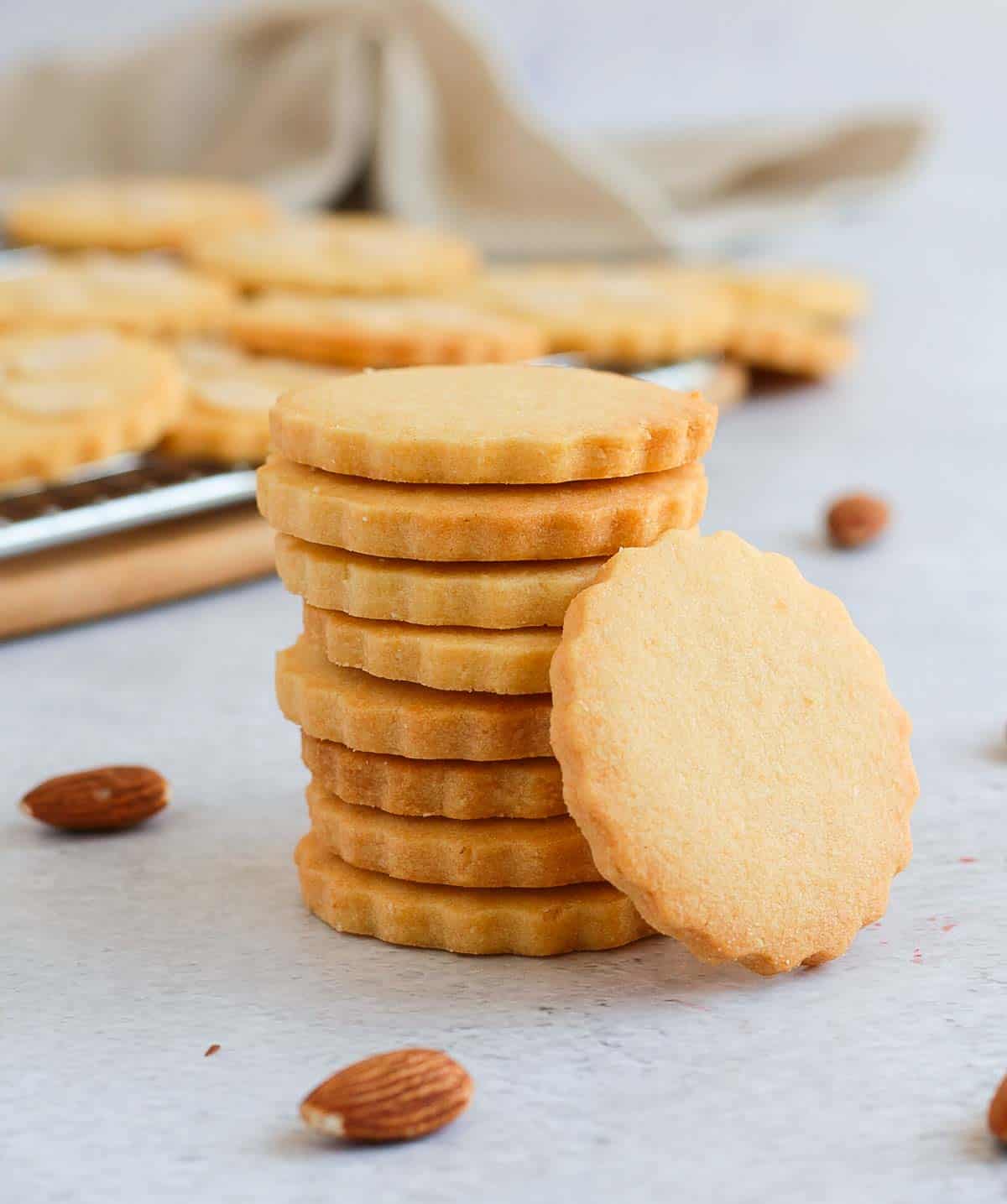
Frequently Asked Questions About Almond Shortbread
Absolutely! While the food processor makes it incredibly easy, you can definitely make these almond shortbread cookies by hand. Follow the same initial steps: combine the dry ingredients (sifted flour, almond meal, and icing sugar). Then, add the cold, cubed butter and use your fingertips or a pastry blender/cutter to “cut” the butter into the dry ingredients until you achieve a fine, crumbly consistency. Finally, add the egg yolk and almond essence and gently knead the mixture by hand until a soft, smooth dough forms. Avoid overworking the dough to keep it tender. Alternatively, for a slightly different texture, these cookies can also be made in a stand mixer using softened butter instead of cold butter, resulting in a more uniform, less crumbly shortbread.
The primary differences lie in their ingredient ratios and resulting texture. As their name suggests, sugar cookies typically contain a higher proportion of sugar, making them sweeter. They often include leavening agents like baking powder or soda, which gives them a softer, slightly chewier texture. Shortbread cookies, on the other hand, are characterized by a significantly higher butter content relative to flour and sugar, and traditionally do not contain leavening agents. This high butter ratio is what gives shortbread its distinctively rich, crumbly, and “melt-in-your-mouth” texture.
Without a doubt, yes! Chilling shortbread dough before baking is a critical step for several reasons. Firstly, it firms up the butter, which prevents the cookies from spreading excessively in the oven, helping them maintain their shape and thickness. Secondly, it allows the gluten in the flour to relax, resulting in a more tender and crumbly cookie. Lastly, a cold dough is much easier to handle and cut into precise shapes without sticking or tearing, especially for cut-out cookies like these almond shortbreads.
Yes, it’s perfectly normal for your almond shortbread cookies to be slightly soft to the touch when they first come out of the oven. They are still quite delicate at this stage. It’s important to resist the urge to move them immediately. Instead, allow them to cool down on the hot baking tray for 5 to 10 minutes. During this time, they will continue to cook slightly from the residual heat and will firm up as they cool. Once they are more stable, you can carefully transfer them to a wire cooling rack to cool completely, where they will achieve their desired crisp and crumbly texture.

Creative Ways to Decorate Your Almond Shortbreads
Once your almond shortbread cookies are baked and cooled, the fun truly begins with decoration! While they are absolutely delightful kept plain, these cookies serve as a perfect canvas for your creativity, especially for holiday gatherings or special occasions. Here are numerous fun and delicious ways to adorn your shortbreads:
- Elegant Almond Flakes: Create a beautiful flower pattern or simple clusters by gently pressing almond flakes onto the cookies before baking, as shown in our photos. The flakes will toast lightly, adding both visual appeal and an extra nutty crunch.
- Chocolate Drizzle with Almond Dust: After the cookies have cooled, drizzle them with melted dark, milk, or white chocolate. Before the chocolate sets, sprinkle a little extra almond meal or finely chopped almonds over the drizzle for a sophisticated finish.
- Chocolate Dipped & Topped: For a more indulgent treat, dip half or a third of each cooled cookie into melted chocolate. Immediately after dipping, press the chocolate-covered portion into a bowl of chopped almond flakes, slivered almonds, or even festive sprinkles.
- Jam Thumbprint Cookies: Transform these into classic thumbprint cookies by gently pressing your thumb or the back of a measuring spoon into the center of each unbaked cookie. Fill the indentation with a dollop of your favorite jam (raspberry or apricot are wonderful choices) before baking.
- Cookie Sandwiches: Take two cooled shortbreads and sandwich them together with a creamy filling! Options include buttercream, ganache, lemon curd, or even a thin layer of Nutella or jam.
- Festive Sprinkles: For a burst of color, press festive sprinkles onto the unbaked cookies before they go into the oven, or sprinkle them over a fresh layer of icing once the cookies are cool.
- Icing or Glaze: Once completely cool, you can ice the cookies with a simple powdered sugar glaze (mixed with a touch of almond essence or citrus juice), royal icing, or even a rich cream cheese frosting for extra indulgence.
Storing & Freezing Your Almond Shortbread Cookies
Proper storage is key to keeping your almond shortbread cookies fresh and delicious for as long as possible. Here’s how:
These delightful Almond Shortbread Cookies can be stored at room temperature in a sealed, airtight container for up to a week, ensuring they retain their crisp texture. If you choose to decorate them with chocolate, as we sometimes do, it’s best to store them in the fridge to prevent the chocolate from melting or becoming sticky. In the refrigerator, they will keep well for up to 10 days.
For longer preservation, these cookies are excellent for making ahead and freezing. You can freeze them for up to 3 months, which is perfect for holiday preparations or having a stash of homemade treats ready at a moment’s notice. When freezing, ensure the cookies are plain, without any decorations or toppings, as these can become soggy or alter in texture when thawed.
First, allow the baked cookies to cool down completely to room temperature. Then, arrange them in a single layer in a freezer-friendly container, separating each layer with a sheet of baking paper to prevent them from sticking together. Alternatively, you can flash freeze them on a baking sheet until solid, then transfer them to a freezer bag or container.
When you’re ready to enjoy them, simply take them out of the freezer and let them thaw at room temperature for a few hours. Once thawed, you can decorate them as desired, if you wish to add a fresh touch before serving.

Explore More Delicious Cookie Recipes
- Nut-Free Florentine Cookies
- Vanilla and Chocolate Marble Cookies
- Oatmeal Peanut Butter Banana Cookies
- Sable Breton Cookies
- Oat Flour Chocolate Chip Cookies
- Chocolate Hazelnut Shortbread Cookies
- Biscoff Butter Cookies
- Lemon Curd Cookies
- Strawberry Cheesecake Cookies
Made this recipe?
Let us know if you liked it by leaving a comment below, and tag us on Instagram @a.baking.journey with a photo of your creation!
Almond Shortbread Cookies Recipe Card
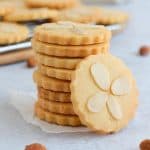
Almond Shortbread Cookies
Servings:
30
Cookies
Author:
Sylvie
20 minutes
15 minutes
1 hour
1 hour
35 minutes
Print Recipe
Prevent your screen from going dark
Ingredients
-
200
gr (1 1/3 cup)
Plain / All-Purpose Flour -
125
gr (1 1/4 cup)
Almond Meal -
70
gr (1/2 cup)
Icing Sugar,
or Powdered Sugar -
180
gr (3/4 cup or 6 oz)
Unsalted Butter,
cold, cut into small cubes -
1
Egg Yolk -
1/2
teasp.
Almond Essence,
or Almond Extract
Instructions
- Place the sifted Flour, Almond Meal and Icing Sugar in the bowl of your food processor (see note 1 if making by hand) and pulse to combine and remove any lumps.
- Add the very cold Butter cut into small cubes and process until you get fine crumbs.
- Add the Egg Yolk and Almond Essence and process until the dough starts to come together (see note 2).
- Place the shortbread dough between two sheets of baking paper and roll it to a 4mm – 1/6 inch thickness (see note 3). Place over a flat tray and leave in the fridge to rest and chill for 1 hour.
- Preheat your oven on 160°C/320°F and line a large baking tray or cookie tray with baking paper.
- Cut out the cookies with your choice of cookie cutter and place them on the baking tray (see note 4).
- Bake for 15 minutes. Leave to cool down on the baking tray for 5 to 10 minutes before transferring to a cooling rack (see note 5).
- Re-roll and chill any leftover dough and repeat the process until all the cookie dough has been baked. Leave plain or decorate as you want.
Would you like to save this recipe?
We’ll email this post to you, so you can come back to it later!
Notes
Yield: This recipe yields a generous batch of approximately 30 cookies. If you desire a smaller batch, you can halve the recipe. Please note that for halving, you will need to estimate approximately half of an egg yolk.
Instruction Notes:
- These shortbread cookies can be successfully made by hand if a food processor is unavailable. Follow the same sequence but manually cut the cold cubed butter into the sifted dry ingredients using your fingertips or a pastry blender/cutter until fine crumbs form. Then, knead in the egg yolk and almond essence until the dough becomes soft and smooth.
- The dough is sufficiently mixed when it is soft, smooth, and cohesive. When pressed, it should easily stick together without crumbling apart.
- For perfectly consistent cookie thickness, which aids in even baking, consider using a rolling pin with thickness rings. While rolling the dough slightly thicker than 4mm (1/6 inch) is an option (baking time might increase by a couple of minutes), we do not recommend rolling it any thinner, as this can make the cookies overly fragile.
- If the dough cracks while cutting out cookies, allow it to sit at room temperature for a couple of minutes to warm up slightly. Conversely, if the dough becomes too soft and difficult to handle or transfer, place it back in the refrigerator (or freezer) for a few minutes to firm up. These cookies hold their shape well and do not spread much, so they can be placed relatively close on the baking tray.
- It is normal for the cookies to be slightly soft immediately after coming out of the oven. For the best texture, let them cool on the baking tray for 5 to 10 minutes before carefully transferring them to a wire rack. They will continue to firm up and achieve their classic shortbread crispness as they cool completely.
Nutrition (per serving)
Calories:
102
kcal
|
Carbohydrates:
8
g
|
Protein:
2
g
|
Fat:
7
g
|
Saturated Fat:
3
g
|
Cholesterol:
19
mg
|
Sodium:
1
mg
|
Potassium:
9
mg
|
Fiber:
1
g
|
Sugar:
2
g
|
Vitamin A:
159
IU
|
Calcium:
12
mg
|
Iron:
1
mg
